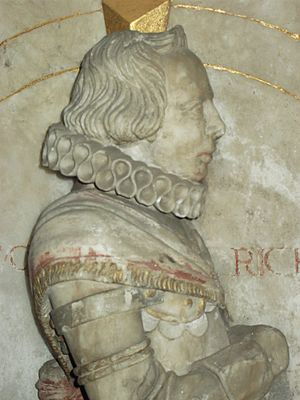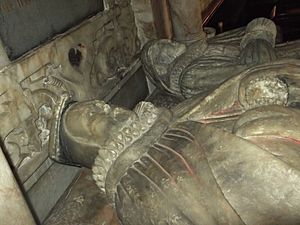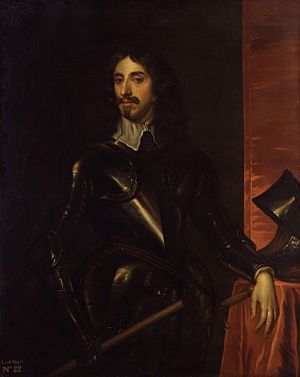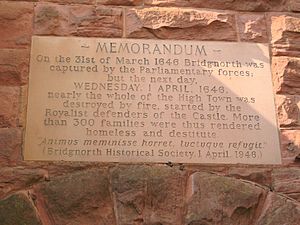Sir Thomas Wolryche, 1st Baronet facts for kids
Sir Thomas Wolryche, 1st Baronet (pronounced WUUL-ritch; 1598–1668) was an English landowner and politician. He served in the House of Commons for Wenlock from 1621 to 1625. During the English Civil War, he fought for the King's side (the Royalists) and was the military governor of Bridgnorth.
Contents
Early Life and Family Background
Thomas Wolryche was born in Worfield, Shropshire. His father was Francis Wolryche of Dudmaston Hall, and his mother was Margaret Bromley. The Wolryche family owned large areas of land in Shropshire, especially around Dudmaston, which is near the River Severn. They got this land through marriage in the early 1400s.
The Bromley family, his mother's side, were famous lawyers and politicians. They had a lot of power in the Welsh marches, which is the border area between England and Wales. Margaret Bromley's uncle, Thomas Bromley, even became a very important judge called the Lord Chancellor.
Thomas Wolryche was born at the home of his mother's nephew, also named Thomas Bromley. His uncle, Edward Bromley, who was a well-known lawyer, was one of his godfathers. Thomas's father passed away in 1614. Because Thomas was still a minor (under 21), his estates could have been controlled by someone else. However, his mother and uncle Edward bought his wardship when he was 16. This meant they could manage his property for him.
Wolryche Family Connections
| Thomas Wolryche's Family | |||||||||||||||||||||||||||||||||||||||||||||||||||||||||||||||||||||||||||||||||||||||||||||||||||||||||||||||||||||||||||||||||||||||||||||||||||||||||||||||||||||||||||||||||||||||||||||||||||||||||||||||||||||||||||||||||||||||||||||||||||||||||||||||||||||||||||||||||||||||||||||||||||||||||||||||||||||||||||||||||||||||||||||||||||||||||||||||||||||||||||||||||||||||||||||||||||||||||||||||||||||||||||||||||||||||||||||||||||||||||||||||||||||||||||||||||||||||||||||||||||||||||||||||
|---|---|---|---|---|---|---|---|---|---|---|---|---|---|---|---|---|---|---|---|---|---|---|---|---|---|---|---|---|---|---|---|---|---|---|---|---|---|---|---|---|---|---|---|---|---|---|---|---|---|---|---|---|---|---|---|---|---|---|---|---|---|---|---|---|---|---|---|---|---|---|---|---|---|---|---|---|---|---|---|---|---|---|---|---|---|---|---|---|---|---|---|---|---|---|---|---|---|---|---|---|---|---|---|---|---|---|---|---|---|---|---|---|---|---|---|---|---|---|---|---|---|---|---|---|---|---|---|---|---|---|---|---|---|---|---|---|---|---|---|---|---|---|---|---|---|---|---|---|---|---|---|---|---|---|---|---|---|---|---|---|---|---|---|---|---|---|---|---|---|---|---|---|---|---|---|---|---|---|---|---|---|---|---|---|---|---|---|---|---|---|---|---|---|---|---|---|---|---|---|---|---|---|---|---|---|---|---|---|---|---|---|---|---|---|---|---|---|---|---|---|---|---|---|---|---|---|---|---|---|---|---|---|---|---|---|---|---|---|---|---|---|---|---|---|---|---|---|---|---|---|---|---|---|---|---|---|---|---|---|---|---|---|---|---|---|---|---|---|---|---|---|---|---|---|---|---|---|---|---|---|---|---|---|---|---|---|---|---|---|---|---|---|---|---|---|---|---|---|---|---|---|---|---|---|---|---|---|---|---|---|---|---|---|---|---|---|---|---|---|---|---|---|---|---|---|---|---|---|---|---|---|---|---|---|---|---|---|---|---|---|---|---|---|---|---|---|---|---|---|---|---|---|---|---|---|---|---|---|---|---|---|---|---|---|---|---|---|---|---|---|---|---|---|---|---|---|---|---|---|---|---|---|---|---|---|---|---|---|---|---|---|---|---|---|---|---|---|---|---|---|---|---|---|---|---|---|---|---|---|---|---|---|---|---|---|---|---|---|---|---|---|---|---|---|---|---|---|---|---|---|---|---|---|---|---|---|---|---|---|---|---|---|---|---|---|---|---|---|---|---|---|---|---|---|---|---|---|---|---|---|---|---|---|---|---|---|---|---|---|---|---|---|---|---|---|---|---|---|---|---|---|---|---|---|---|---|---|---|---|---|---|---|---|---|---|
|
|||||||||||||||||||||||||||||||||||||||||||||||||||||||||||||||||||||||||||||||||||||||||||||||||||||||||||||||||||||||||||||||||||||||||||||||||||||||||||||||||||||||||||||||||||||||||||||||||||||||||||||||||||||||||||||||||||||||||||||||||||||||||||||||||||||||||||||||||||||||||||||||||||||||||||||||||||||||||||||||||||||||||||||||||||||||||||||||||||||||||||||||||||||||||||||||||||||||||||||||||||||||||||||||||||||||||||||||||||||||||||||||||||||||||||||||||||||||||||||||||||||||||||||||
Education and Land Ownership
Thomas Wolryche started studying at Trinity College, Cambridge in 1614. His uncle, Edward Bromley, then helped him get into the Inner Temple, a famous place for training lawyers, in 1615. Edward Bromley saw Thomas as someone he could help in politics.
Thomas's father, Francis Wolryche, had many debts. When he died, his will named Edward Bromley and Roger Puleston as trustees to manage the estates until Thomas was 30.
Dudmaston, Thomas Wolryche's main home, was part of an 800-acre estate. In total, the Wolryche family owned about 4,500 acres of land, mostly in southern and eastern Shropshire. This included the area of Wroxeter. In 1611, Thomas's father had taken over a debt for his brother-in-law, William Gatacre. This debt was for £1,740. Thomas finally cleared this debt in 1623 by paying it off and gaining full ownership of Hughley, an estate of 1,400 acres.
Political Career in Parliament
Edward Bromley, Thomas's uncle, was the recorder (a type of judge) for Much Wenlock. This was a small town known for its wool trade, which was declining at the time. The area around Wenlock had many wealthy families. Thomas Wolryche's ownership of Hughley gave him a connection to this area. His uncle's influence helped him get involved in local politics.
Wolryche was chosen as a Member of Parliament (MP) for Wenlock on January 2, 1621. He was also made a "freeman" of the town on the same day. He was re-elected as MP for Wenlock in 1624, during the last years of King James I's rule. He was elected again in 1625, for the first parliament of King Charles I. These were times when the relationship between the King and Parliament was becoming very tense.
However, Wolryche did not play a big role in the House of Commons. He was appointed to a few committees, but he didn't make a strong impact. His time in Parliament ended when his uncle, Edward Bromley, became ill. Francis Smallman took his place in the 1626 elections. Sir Edward Bromley died later that year.
The English Civil War
Leading Up to the War
Wolryche was a strong supporter of King Charles I. However, his mentor, Edward Bromley, had been a moderate Puritan and had friends who disagreed with King Charles I's policies, like "ship money" taxes. Wolryche was involved in collecting taxes for Charles I in 1627 and 1628-29. These taxes were part of the reasons why the King decided to rule without Parliament from 1629 to 1640.
Wolryche was a local Justice of the Peace. In 1632, he was suggested to become High Sheriff of Shropshire, a very important local position. However, he was not chosen for the role.
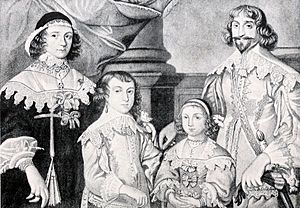
As tensions grew between King Charles I and Parliament in 1641, the King tried to gain support and money. He did this by making many people knights and baronets. Wolryche was made a knight on July 22, 1641, and then the first of the Wolryche baronets on August 4, 1641. But this didn't guarantee loyalty to the King. Many wealthy people in Shropshire, including some of Wolryche's relatives, supported Parliament. For example, his sister Elizabeth and her husband John Puleston were strong Presbyterians and had to leave their home.
The influence of Francis Ottley seems to have been very important in Wolryche's decision to support the King. Ottley was Wolryche's brother-in-law (Wolryche married Ottley's sister, Ursula, in 1625). Ottley was very committed to the Royalist cause and kept up with political news. Wolryche agreed to collect the Poll Tax in 1641. In the summer of 1642, as both the King and Parliament prepared for war, both Wolryche and Ottley received orders from the King to raise an army. Wolryche already had experience leading a local militia.
Shrewsbury was not naturally a Royalist stronghold. There had been conflicts between different religious groups there for many years. On July 16, a group of Shrewsbury leaders asked Parliament to recognize a local militia. Parliament agreed and sent three MPs to take military control of Shropshire. One of these MPs was Sir John Corbet, 1st Baronet, of Stoke upon Tern, who was Wolryche's second cousin. However, Francis Ottley acted first. He stopped the Parliament's military gathering on August 1. This allowed Royalist forces to gather the next day under Sir Vincent Corbet.
On August 8, Wolryche was among the important county leaders who signed a "declaration" at the Shrewsbury court. This statement, inspired by Ottley, said they would support the King in preparing the county for war. They promised to risk their lives and fortunes to defend the King, the Protestant religion, the Parliament's rights, and the laws of the country.
This strong support convinced the King to move his army from Nottingham to Shrewsbury. He arrived on September 20 and stayed until October 12. Ottley took control of Shrewsbury during the King's stay and was later officially named military governor of the town. It was probably Ottley who suggested Wolryche for the position of governor of Bridgnorth. Early in the war, Wolryche was also appointed a Deputy Lieutenant of Shropshire.
Defending Bridgnorth
The council of Bridgnorth had thought about adding a drawbridge to the bridge over the River Severn as early as August 26. But they decided to use ropes and chain barriers instead. Prince Rupert arrived in the town on September 21 and made sure that two loyal Royalist officials were chosen for the next year. When the King left Shrewsbury on October 12, he came to Bridgnorth. He stayed for three days with Sir William Whitmore at Bridgnorth Castle. He quartered his army of 14,000 soldiers with the local people before moving on.
Wolryche seemed to leave most of the town's defense plans to the council. It wasn't until November 29 that they decided to set up a "watch and ward" (guards) as the officials directed. In December, Wolryche's name was again prominent in a pledge by Shropshire gentlemen. They promised to raise a regiment of Dragoneers (soldiers who could fight on horseback or on foot) to defend the King and country.
However, an embarrassing event happened soon after. Wolryche and his friends, wanting to continue drinking as in peacetime, allowed a dangerous Parliament supporter to escape capture. On January 19, Wolryche and others were in Bridgnorth, making a deal with a wine merchant named John Birch. A warrant arrived from Ottley, demanding Birch's arrest because he was "disaffected" to the King and acting as a "traitor." Wolryche and the others wrote to Ottley the next day, offering to pay bail so Birch could continue his business. Birch later fought for Parliament and led a successful campaign against the Royalists.
Meanwhile, the people of Bridgnorth worked to improve their own protection. On January 25, the council agreed to pay for nine dragoons. They also organized the watch more efficiently, with captains for day and night. A man named Corbet began training the young men of the town for defense.
In March 1643, Wolryche led a small force out of the county to help a Royalist attack on Lichfield. On his return, in May, Wolryche faced stricter demands from the town council. These demands came from Lord Capell, the regional Royalist commander. The council wanted fortifications built around Bridgnorth and all men to help with the work. They also wanted volunteers to bear arms and train weekly.
Francis Billingsley brought more professionalism to Bridgnorth's defense. However, Wolryche never seemed to fully adjust to the demands of war. In June, he complained to Capell about a local official who wasn't collecting taxes and supplies for the King well enough. Yet, when a relative complained about Royalist soldiers stealing horses, Wolryche quickly asked Ottley for help getting them back.
Ottley was removed as governor of Shrewsbury in February 1644. It seems Wolryche was also replaced around the same time, perhaps when Prince Rupert visited Bridgnorth. His replacement was Sir Lewis Kirke, a tough soldier. Kirke and Billingsley set up a small committee to manage Bridgnorth's defenses. However, Kirke was later accused of using torture to stop opposition within the town.
Defeat and What Happened Next
Wolryche remained active until at least August 1645. He was not present when Bridgnorth was captured on March 21, 1646. At that time, Kirke was still the commander. The Royalist soldiers set fire to the town, which was mostly destroyed. An inscription on the North Gate Museum in Bridgnorth mentions this. The townspeople had thrown stones at the soldiers as they retreated into the castle, showing that the people were against the Royalist occupation by then. The damage was estimated at £60,000.
Wolryche surrendered to Parliament on very easy terms. This was similar to the terms given to the defenders of Bridgnorth Castle. Wolryche was imprisoned once and had his property seized twice. On March 11, 1647, he was fined £730, which was only a tenth of the value of his estates. This was because William Pierrepont, the MP for Much Wenlock, appealed on his behalf. Wolryche still had many debts in 1657. He made a will to repay them, but he later changed this plan.
Death and Family
Sir Thomas Wolryche died on July 4, 1668, at the age of 70. He was buried at St Chad's Church, Shrewsbury on July 9, 1668. There is a memorial stone for him in the family's church, St Andrew at Quatt.
Wolryche married Ursula Ottley in Pitchford, Shropshire, on May 4, 1625. They had seven sons and two daughters. Their first child, Margaret, was baptized on May 30, 1626. Their first son, Francis, was baptized on October 21, 1627.
Francis automatically became the next Baronet, but he had a mental illness that prevented him from managing the family property. The estates were put into the care of John, their fifth son. This arrangement was made official by a special law passed by Parliament in 1673. John was elected MP for Much Wenlock, just like his father, in 1679 and 1681. John died in 1685, three years before Francis. So, it was John's son, Thomas, who inherited both the title and the estates in 1688.
|


